If you liked my posts about driving in Europe, you also should read what Buzz Andersen (of PodWorks fame) writes about this subject. And thanks for the kind words, Buzz…
Browsing Posts in Travel
Some interesting advertising from Europe. On the very first day, inside Amsterdam’s Schiphol airport, we ran into this specimen of Lepidoptera Centrinia advertising for Intel. Brrh… I’m glad I have a Mac…
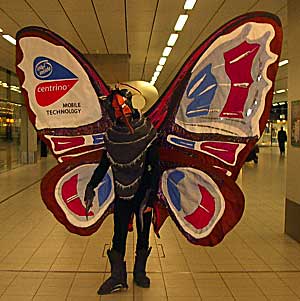
I found this in a small town before München, advertising for a print service bureau:

the left vertical text means “Large formats” and the top horizontal text means “Digital Press”. 😆
This ad was in the Berlin subway. It’s for a campaign pleading “more time for kids”:
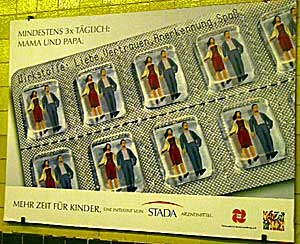
and the text says: “Take at least 3x every day: Mom and Dad. Active ingredients: love, trust, recognition, fun”. Cute…
We ended up with some matchboxes with ads from various hotels, but I didn’t want to take them on the plane, as they’re on the list of proscribed items. So I took a picture:

The small matches are only about 15mm long, I certainly didn’t try to strike one.
Here are some more pictures from our Europe trip. Here’s a “Dolce Vita” car from Prague:
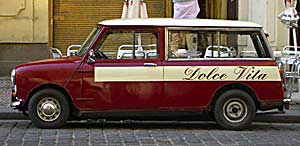
(I think it’s a Morris, but I’m not sure.)
This pedal-driven Mercedes for kids was in a Mercedes store on Berlin’s famous Kurfürstendamm:

Despite its appearance, this is not a car:

but rather a tractor for pulling machines for agricultural and road-building work. Notice the lack of a number plate and the central steering wheel. I found this in Berlin’s Technology Museum; it’s from the early 20th century.
Remember the recent story when Thailand’s Finance minister got trapped inside his BMW?
A high-ranking Thai official was forced to crawl out of the shattered windows of his luxury car following an onboard glitch that sealed all exits.
BMW has told CNETAsia that an electronic fault caused the problem, rather than a system crash of the car’s Windows-based central computer, as other reports have speculated.
In Prague, another Brazilian couple was staying at the same hotel we were in. They did one of those fly&lease plans and, as a part of that, had leased a brand-new Renault Mégane:

This is one of those computer-controlled new cars; a complicated dashboard display, no car keys or ignition, everything’s done by a keychain remote control. Very nice while it works…
It seems they drove into the parking lot with headlights on, got out, and turned the car off with the remote. One of them put the remote into a pocket where it presumably pressed again by mistake while they were going away. The result: the car was completely unlocked (including the trunk) and the headlights were turned on again.
In the morning, after checking out of the hotel, the car was completely dead. Nothing worked, all doors and the trunk were open. A helpful camper owner offered to help jump-start the car with the usual jumper cables; after connecting them and running the camper’s motor for several minutes, the Renault worked again, or at least partly; the lights could be turned on and off. However, the doors wouldn’t lock and the car wouldn’t start either; the dashboard kept displaying a message to “Call Service”.
We helped them look through the lease papers and located a service number in France. When we left, they’d already been on hold for over half an hour (at 2 Euros per minute!). Today, they called us and told the rest of the story…
It seems that once they succeeded to get a real live person on the phone in France, things happened very quickly. They said where they were in Prague and in about 45 minutes the local Renault dealer sent a repairman. He installed a new battery and reset the computer. They immediately got into the car and drove all the way into Austria, where they have relatives; they were afraid to turn the car off, so they left it running while tanking or eating. 😆
This turned out to be a wise precaution; after they’d parked the car in their relatives’ garage, the next day it was dead as a doornail again. After yet another visit from the local Renault repairman, everything was finally fixed… but guess if they’ll want another “smart” car again!
This is a very serious issue. Leaving aside the obvious jokes about cars, airplanes and even aircraft carriers running Windows CE, I think that onboard “smart” electronics must be smarter than that. Why didn’t the computer detect that the headlights were on, and turn them off before allowing the battery to run down past the point where the car couldn’t function?
One thing I noticed about the many Smart cars I saw in Europe: nearly all of them had company logos. I suppose they’re the ideal company car; small, easy to park and with excellent mileage. By the way, they’re also the least expensive to rent. Here’s one I shot in Vienna:
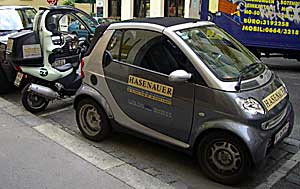
Notice the company motorbike behind it? That’s a BMW C1, it has a rollbar and seatbelt. Here’s a better picture:

Those two were for rent in the small alpine town of Füssen.
Now, I’ve never learned to handle a motorbike (or even a normal bycicle, to the amazement of my German relatives), but this one looks like the right bike for me:

this is a “velotaxi”, you see them quite a lot in Berlin – two passengers fit in the back. At least I wouldn’t fall off this one… then again, Belo Horizonte, where I live, is hillier than San Francisco, so it really wouldn’t be useful.
More than any other countries I’ve visited, Germany and Austria reflected my own predilection for small cars. Though you see quite a number of vans and mid-sized luxury sedans, small is definitely in, mostly (I suppose) for practical reasons. In a small town at Lake Constance, the owner of this small delivery vehicle was quite puzzled why I wanted to take a picture of it:
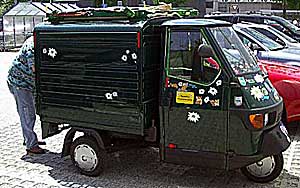
while in München, we saw this lovingly maintained Morris Mini:

The absolute king of the small-car universe, however, seems to be the Mercedes/Swatch-built Smart two-seater. Here’s a nice one:

and of course, the XRay plates are very cool – wish I had one!
While the basic Smart can be found in Europe for 8500 Euros and up (US$9400), here in Brazil prices start at R$75000 (US$25000), because of taxes and import duties. Supposedly the Mercedes factory in Brazil will start to build Smarts in a couple of years; unfortunately, they’ll probably be the larger four-seat model. A pity, the two-seater is just 2.5m long and the ideal car for congested large cities…
Stopping and parking is not as easy as it sounds, at least in Europe. Forget about stopping on the Autobahn; you’ll either get rear-ended or a rescue car will appear sooner than you wish (unless, of course, you really need to be rescued). Every 20 Km or so you’ll find clearly designated rest stops, some with restaurants. Expect to pay to use the restroom in most roadside restaurants, 0.30 to 0.50 Euros is usual. Most secondary highways have no shoulder for stopping, so you’ll need to look either for a designated view point or rest area, or for an agricultural (dirt) road leading off into a field. If the latter, watch out for farmer’s rigs and don’t stop for long.
In cities, watch out for signs regulating stopping and standing: 
Two stripes, as pictured, mean that you shouldn’t stop (for any reason); one stripe means you can stop briefly for looking at a map or loading/unloading. Arrows may indicate that the sign applies to one side of the road only, and times/dates may indicate that the restriction applies only during certain periods.
Parking is even harder than in the US or Canada. Parking meters are common in some cities, but not all. In Germany, you’ll find that many streets require you to put a “Parkscheibe” on the dash; this is a cardboard disk which you must turn to the hour when you parked, and you’re not allowed to stay longer than a certain number of hours. (Rental cars should come with one of these.) It’s also common to find that, during certain hours, parking is restricted to residents who must display special permits or stickers.
Even small cities usually have public parking lots or buildings, which unfortunately can be quite expensive; count on paying between 1.50 and 3 Euros per hour. If you’re staying longer than a few hours in a larger city, look for parking lots with the “P+R” (park & ride) logo; they usually charge a fixed rate of a couple of Euros for the whole day and are located near a subway or tram station. Some don’t allow leaving the car overnight, though. Most hotels have a garage for guests but charge extra for it; 6 to 15 Euros per night is usual.
Inside medium or larger cities, getting around by subway or tram is much better than using a car. Every city we visited had some form of day card; you pay a fixed fee and for that day (or for the next 24 hours) can take unlimited rides on any public transportation. In a few cities, such as Düsseldorf, there are day cards for groups of up to 5 persons; in others, there are family cards for 3 or more people. Usually, unless you just go to a certain point and back, the cards are better deals than single tickets. There are even better deals for longer stays.
Be aware that public transportation in Europe usually works on the honor system; you must have a valid ticket in your pocket before entering the subway station (or boarding the tram). Tickets are never sold inside a tram or subway. Most tickets must be validated at a stamping machine which can be located either inside the station or in the tram or subway, but never in both; be careful not to get confused. Plain-clothes policemen make spot checks for tickets, and fees for not carrying a valid ticket usually range from 50 to 100 Euros.
Traffic laws are generally uniform in all countries we visited; if you’re used to driving in the US or Canada, be sure to look up details, as there are some differences. Turning right on a red light is never allowed, and overtaking another car on the right is generally forbidden. There are complex precedence rules; unless specifically signed, the car coming from your right has precedence if all else is equal. Expect people to know and respect these rules; especially German drivers have a habit of not even looking to the left when crossing an intersection. Things are a little more relaxed in Eastern Europe, though, except for drinking and driving, where there’s absolutely zero tolerance for alcohol.
Unless otherwise indicated and depending on the country, speed limits are 50 Km/hour in urban areas, 90 or 100 Km/hour on secondary (single-lane) highways, and 120 or 130 Km/hour on divided (multi-lane) highways. The German Autobahn is an exception; there’s a minimum speed of 60 Km/hour, a recommend speed of 130 Km/hour, and no speed limit at all in the leftmost lane. Avoid that lane unless you have a high-powered car and practice driving at high speed; as I had neither, I usually puttered along at a glacial 120 Km/hour.
In contrast, Brazilian highways have a speed limit of 80 Km/hour for single-lane and 110 Km/hour for multi-lane; one is usually advised to drive slower because of the frequent pot-holes. In Europe I didn’t see a single pothole outside of the quite frequent and very well signed road work areas.
Keep an eye on what other drivers do in regard to speed limits. In most areas everybody drove at or at most 10 Km/hour over the limit. Pedestrians are usually respected, except for Hungary, where they drive more like they do in Brazil – meaning, don’t expect a driver to stop just because you stepped on the road. German and Austrian drivers are the most mild-mannered ones, except on the Autobahn, where most suddenly turn into raving maniacs.
Generally there are no multi-language highway and traffic signs, so it pays to look up and memorize some common words like “exit”, “attention” and so forth in the various languages. Here’s a good site further detailing the various signs and traffic laws. Here’s another one. Signs vary considerably from American conventions in some respects, most rental car companies will give you a chart if you ask for one.
